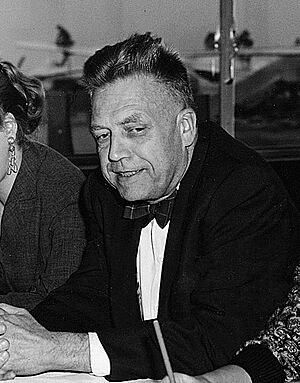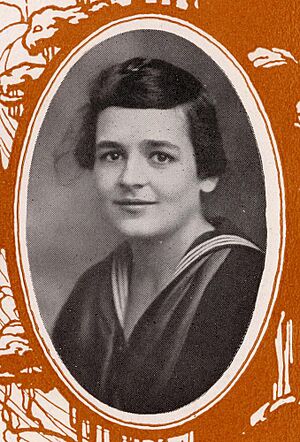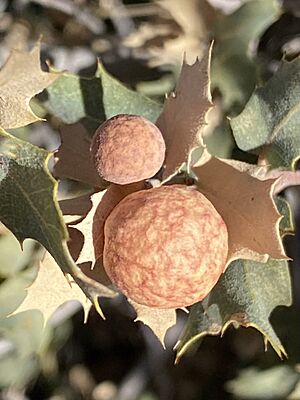Alfred Kinsey facts for kids
Quick facts for kids
Alfred Kinsey
|
|
|---|---|

Kinsey in Frankfurt, November 1955
|
|
| Born |
Alfred Charles Kinsey
June 23, 1894 Hoboken, New Jersey, U.S.
|
| Died | August 25, 1956 (aged 62) Bloomington, Indiana, U.S.
|
| Education |
|
| Spouse(s) |
Clara McMillen
(m. 1921) |
| Children | 4 |
| Scientific career | |
| Fields | Biology |
| Institutions | Indiana University Bloomington |
| Doctoral students | |
Alfred Charles Kinsey (June 23, 1894 – August 25, 1956) was an American biologist. He was also a professor who studied entomology (the study of insects) and zoology (the study of animals). He is known for his important scientific work and for writing a popular high school biology textbook.
Contents
Early Life and Education
Growing Up in New Jersey
Alfred Kinsey was born on June 23, 1894, in Hoboken, New Jersey. He was the oldest of three children. His mother, Sarah Ann, did not have much formal schooling. His father, Alfred Seguine Kinsey, was a professor at Stevens Institute of Technology.
Kinsey's parents were very religious Christians. His father was a strong member of the local Methodist church. Young Alfred often spent time with other church members. His parents had strict rules at home, like making Sunday a day mainly for prayer.
Childhood Health Challenges
For much of his childhood, Kinsey's family was poor. They often could not afford good medical care. This might have led to him getting sick with diseases like rickets, rheumatic fever, and typhoid fever. His health records show he did not get enough sunlight, which can cause rickets. He also lived in unhealthy conditions sometimes. Rickets caused his spine to curve slightly. This stoop later prevented him from being drafted for World War I in 1917.
Love for Nature and Scouting
When he was 10, Kinsey's family moved to South Orange, New Jersey. From a young age, he loved nature and camping. He worked and camped with the local YMCA for many years. He enjoyed these activities so much that he planned to work for the YMCA after college.
Kinsey joined the Boy Scouts when a troop started in his town. His parents strongly supported this because the Boy Scouts was based on Christian values. He worked hard and earned the Eagle Scout award in 1913. This made him one of the first Eagle Scouts ever. Even though he had a weakened heart from childhood diseases, Kinsey went on many difficult hikes and camping trips.
High School and College Choices
In high school, Kinsey was a quiet but dedicated student. He focused on his schoolwork and playing the piano. At one point, he hoped to become a concert pianist. However, he decided to focus on science instead. Kinsey was able to spend a lot of time deeply focused on his studies. This skill helped him greatly in college and his career. He did not make many close friends in high school but was respected for his academic abilities.
While in high school, Kinsey became interested in biology, botany (the study of plants), and zoology (the study of animals). He later said that his high school biology teacher, Natalie Roeth, was the most important person who influenced him to become a scientist.
Kinsey wanted to study botany in college. But his father insisted he study engineering at Stevens Institute of Technology. At Stevens, he mostly took English and engineering classes. He could not study biology, which he loved. Kinsey did not do well there and realized engineering was not for him. After two years, he bravely told his father he wanted to study biology. He then transferred to Bowdoin College in Maine, where he majored in biology.
Research on Entomology
College and Graduate Studies
In the fall of 1914, Kinsey started at Bowdoin College. He studied entomology under Professor Manton Copeland. In 1916, Kinsey was chosen for the Phi Beta Kappa society, which honors smart students. He graduated with high honors in biology and psychology. His father did not attend his graduation, perhaps still unhappy with his son's career choice.
Kinsey continued his studies at Harvard University's Bussey Institute. This was one of the best biology programs in the United States. There, he studied applied biology with William Morton Wheeler, a famous entomologist. Kinsey worked mostly on his own, which suited both him and Professor Wheeler.
Studying Gall Wasps
Kinsey wrote his advanced degree paper on gall wasps. He was very enthusiastic about collecting samples of these tiny insects. He traveled widely and took 26 detailed measurements of hundreds of thousands of gall wasps. His careful way of studying them was a big step forward for entomology.
In 1919, Kinsey earned his Doctor of Science (ScD) degree from Harvard University. He then accepted a job teaching biology at Indiana University. In 1920, he published several papers about gall wasps. He introduced them to the scientific world and described their family tree. Out of more than 18 million insects in the American Museum of Natural History's collection, about 5 million are gall wasps collected by Kinsey.
Writing Textbooks
Kinsey wrote a widely used high school textbook called An Introduction to Biology. It was published in October 1926. This book was different from others because it strongly supported evolution. It also combined zoology and botany, which were usually taught separately.
The book explained evolution in a simple, factual way. Kinsey defined evolution as "the scientific word for change." He showed students how to find proof of evolution in everyday things. He joked about people who said they didn't believe in evolution but owned a new dog breed or smoked a new kind of tobacco. He would ask, "When he says he doesn't believe in evolution, I wonder what he means."
In 1943, Kinsey also helped write Edible Wild Plants of Eastern North America with Merritt Lyndon Fernald. He had started writing this book much earlier, around 1919–1920.
Personal Life

Kinsey was raised as a Methodist. For a time, he became a less strict Congregationalist. During his studies at Harvard, he became agnostic or atheist. This meant he replaced his strong religious beliefs with a strong passion for science.
He married Clara McMillen in 1921. His father, Alfred Sr., did not attend his wedding, just like he missed his college graduation. Alfred and Clara had four children. Their first son, Donald, was born in 1922. He sadly died in 1927, just before his fifth birthday, from complications of juvenile diabetes. Their first daughter, Anne, was born in 1924, followed by Joan in 1925, and their second son, Bruce, in 1928.

Kinsey designed his own house in the Vinegar Hill neighborhood of Bloomington, Indiana. It was located at 1320 First Street. There, he enjoyed his great interest in gardening.
Alfred Kinsey passed away on August 25, 1956, at the age of 62. His death was caused by a heart problem and pneumonia. He was buried at Rose Hill Cemetery in Bloomington, Indiana.


